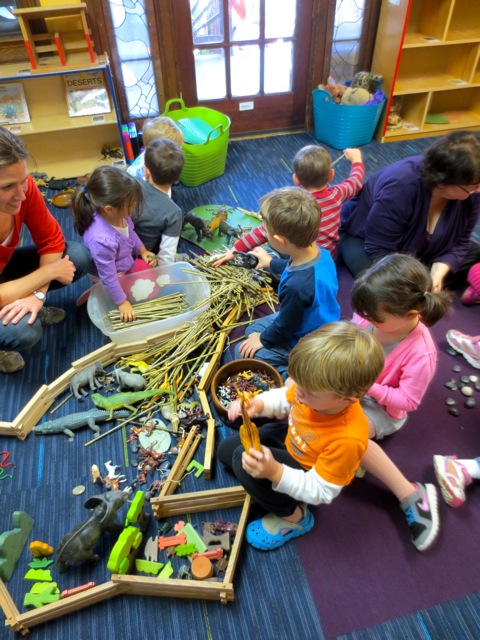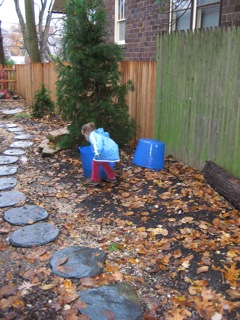Implicit and Explicit Designs of Early Childhood Environments
 As you look for and at your child's next educational experience, it is helpful to think about how your child interacts with an environment's explicit and implicit design. Environment in education encompasses not just the physical space, but also the routines, the schedule, the materials (curriculum), number of children enrolled, and the staffing. A tall order for the educator, to be sure, but we know that the environment is prepared for the child, not the child for the environment.
As you look for and at your child's next educational experience, it is helpful to think about how your child interacts with an environment's explicit and implicit design. Environment in education encompasses not just the physical space, but also the routines, the schedule, the materials (curriculum), number of children enrolled, and the staffing. A tall order for the educator, to be sure, but we know that the environment is prepared for the child, not the child for the environment.
Each school you visit will have all of this taken into consideration. Educators are trained to think of the message that is sent upon walking in the door of a school or classroom. Sometimes the physical plan of the school, the administrative oversight, or philosophical underpinnings either limit or overtly guide design. For instance, a Montessori school's environment will be different than a public school. As an example of physical plan limitations...At our school, we enter through the back of the school. This is for safety reasons (our front lot is devoted to parking and there is lots of traffic). Once that was established as a need, the design presents sandpit and Teahouse upon walking in past the gate. "Children play here," it says. Once inside, the chairs and tables are scaled and there are materials that also signal to children, "Play here. This is for you."
These are all parts of an implicit design. Not all children read these cues and some read them in varying ways, each receiving a subtly different message from one child to the next. So we move on to an explicit design -- "hang up your backpack, wash your hands, and put up your symbol." There is an arrival routine in almost every school I have ever visited, even if it is as simple as hang up your coat and take of off your boots.
Arrival time at our school does not just include this routine. It includes time for acclimation...for leaving one experience like home, daycare, or whatever activity comes before arriving at our School. The arrival routine is giving this transition a book-end or beginning of a sentence.
Some children will bypass that arrival routine and go straight to the toys or books while others will follow through with the routine and then move on. There is a child in the Leaves class this year who, after doing steps 1 and 2, beelines straight to the Imaginary Play shelf materials so quickly and with laser-focus that a whole small world has been set up before you even know that she has walked in the door. The implicit design is really working for her.
Another of the Leaves comes straight to the circle table after steps 1 and 2 and sits, watching for about 10 breaths, visibly settling and steeling herself to the bustle of the classroom before calmly getting up and choosing a tray from the Think Tank shelf. The implicit design is also working for her, but in a different way than the first child. The explicit design, step 3. of the arrival routine, is missed because they are just 3. There is an assumption that they will complete the 3-steps as they approach 3 and a half. There are 16 other ways the children will interact with that arrival space at the beginning of their day. Some will stand at the door, waiting, others will cry about the leaving and going, transitions are hard. The implicit and the explicit designs are not working for them.
We have strategies in place to ease transitions including our hello-goodbye window and checklists and maps to get through the day. When a child gets stuck at the door, she or he does not need to be crowded, the crowd is the thing stopping the child at the door! An adult descending on this child to provide direction is not necessarily the thing to do. This child is acclimating by standing and watching. A map is needed so that the space, with its implicit design, can be navigated without extra interference. The implicit needs a jumpstart. We create storyboards and social stories to help this child walk past the threshold.
While arrival has an explicit routine attached to it, the what to do next is implicit. This is an important part of the design because it provides children with the autonomy and creative bandwidth to engage at their own pace, with their own interests. This implicit design works for the majority of children with only minimal support. Once these supports are in place, they are used for a period of time, and then are simply no longer needed. The jumpstart has been provided, the child is now able to interact with the implicit design.
In the way of exploring how the philosophical underpinnings of a program influence design, I would use how we approach dramatic play at our school. Dramatic play features an explicit set-up in our environmental design. We have a meeting before each session that begins with a "together game" and then launches directly into what I call an "agree to agree" meeting. This is what sets our program apart from other programs. Most programs will present the "housekeeping corner" or dramatic play area shaped as an implicit design. Implicit design of a dramatic play space works for many children, but not for all. The ability to engage in dramatic play or imaginary play is an essential skill set for humans. We leave nothing to chance here. The design shifts from implicit -- which is what you find at most schools -- to explicit. We collaboratively answer the questions of who will you be, what will happen, the agree to agree of dramatic play and then we proceed. We also review and debrief afterwards so that the social play begun there can extend beyond our classrooms, to the outside, and eventually to the greater community.
As a side note in the area of physical plan and its limitations, sadly for art projects or the project center environment, the implicit and explicit design is muddy because of the physical plan of our current site. If we had a purpose built studio like we used to have, the design for this experience would reflect the intentionality of everything else we do.
Interestingly, and this speaks volumes of the human experience, our outdoor play environment is completely implicit. Very little needs to be established for children to interact with this environment because so much intentionality has been invested in shaping its destinations. That said, there has to be opportunities for intentional scaffolding in how to signal play, how to interpret play overtures, and how to understand play arcs.
All of this discussion about design should help you understand and make connections with your child's next school experience. Think about what you have observed in your own child. How does she or he interact with environments? You can easily see the patterns of engagement with not just our environment, but with any other environment's implicit and explicit designs. You already know whether or not your child needs or doesn't need support systems. You should share this information freely with your child's next teacher. And then, and this is important, trust in the supports and environment your child's next teacher shapes and your child's ability to accommodate and embrace change.



